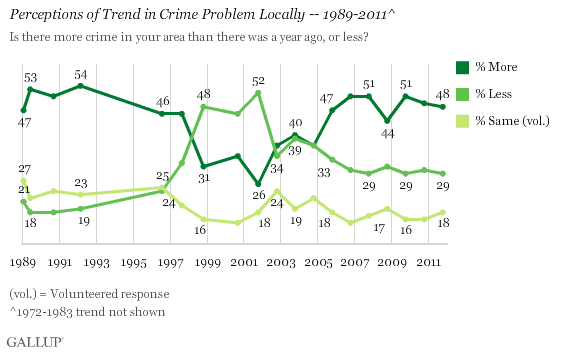PRINCETON, NJ -- Despite a sharp decline in the United States' violent crime rate since the mid-1990s, the majority of Americans continue to believe the nation's crime problem is getting worse, as they have for most of the past decade. Currently, 68% say there is more crime in the U.S. than there was a year ago, 17% say less, and 8% volunteer that crime is unchanged.

In contrast to the 68% of Americans who say crime is getting worse nationally, 48% say crime in their local area is worsening. However, the trend in perceptions of local crime follows the same pattern. Nearly half of Americans say there is more crime where they live today than there was a year ago, similar to the percentage saying this in the past several years, as well as when crime was rising in the early 1990s.

Gallup's crime perception trends do show that Americans grew significantly more positive about the direction of crime between 1996 and 2001. Attitudes were the most positive in 2001, when slightly more Americans said crime in the U.S. was declining rather than increasing. This was at a time when the number of violent crimes per 1,000 people nationally had already fallen dramatically, from roughly 51 in 1994 to 25 in 2001, according to the federal Bureau of Justice Statistics. Since then, violent crime victimization has dropped an additional 40%, descending to 15 crimes per 1,000 in 2010. The trend in property crime has also declined over this period, falling by 28%.

Ratings of Seriousness of Crime More Stable
A separate Gallup measure asks Americans to rate the seriousness of the crime problem today, both in the U.S. and where they live. In contrast to Americans' responses to the question asking if the crime problem is getting better or getting worse, responses to this "current situation" question have been largely flat since these measures were established in 2000. For most of this period, the majority have said crime in the U.S. is extremely or very serious, while just over 10% have said this about crime in their local area.

Thus, even though the majority of Americans in recent years have said the problem of crime is worsening, their ratings of the seriousness of the crime problem both in the U.S. and where they live have not changed a great deal.
About 4 in 10 Feel Unsafe Walking Near Their Home at Night
Despite the relatively low level of concern about local crime, 38% of Americans say there is an area within a mile of where they live where they would feel unsafe walking alone at night. Gallup has been using this measure of Americans' feelings of security from crime for more than 45 years, and the responses have ranged from a high of 48% in 1982 to a low of 30% in 2001. The 2001 low point was measured within weeks of the Sept. 11, 2001, terrorist attacks that temporarily lowered Americans' concerns about conventional crime while elevating concerns about a terrorist attack. Since that point, feelings of being unsafe based on this measure have risen somewhat, although they are not quite as high now as they were from the late 1970s through the early 1990s.

Bottom Line
The government's U.S. crime statistics have been improving steadily over the past 15 years, but several Gallup measures of Americans' perceptions of crime, after growing more positive for a brief period a decade ago, have edged back to a more highly negative outlook. More than half now say the nation's crime problem is extremely or very serious, and two-thirds say it is getting worse.
This unwarranted pessimism may stem from the imperfect indications of crime that Americans receive from the news and other sources, as well as Americans' overall mood. In line with this point, the view that crime is worsening could reflect the broader decline in Americans' optimism about the country, as satisfaction with the way things are going declined from 71% in 1999 to 7% in 2008; and, after slightly higher ratings in 2009 and 2010, it is now back down to 13%. Whatever the case, there is a positive story to be told about the nation's violent crime problem that Americans haven't yet fully heard or absorbed.
Survey Methods
Results for this Gallup poll are based on telephone interviews conducted Oct. 6-9, 2011, with a random sample of 1,005 adults, aged 18 and older, living in all 50 U.S. states and the District of Columbia.
For results based on the total sample of national adults, one can say with 95% confidence that the maximum margin of sampling error is ±4 percentage points.
Interviews are conducted with respondents on landline telephones and cellular phones, with interviews conducted in Spanish for respondents who are primarily Spanish-speaking. Each sample includes a minimum quota of 400 cell phone respondents and 600 landline respondents per 1,000 national adults, with additional minimum quotas among landline respondents by region. Landline telephone numbers are chosen at random among listed telephone numbers. Cell phone numbers are selected using random-digit-dial methods. Landline respondents are chosen at random within each household on the basis of which member had the most recent birthday.
Samples are weighted by gender, age, race, Hispanic ethnicity, education, region, adults in the household, and phone status (cell phone only/landline only/both, cell phone mostly, and having an unlisted landline number). Demographic weighting targets are based on the March 2010 Current Population Survey figures for the aged 18 and older non-institutionalized population living in U.S. telephone households. All reported margins of sampling error include the computed design effects for weighting and sample design.
In addition to sampling error, question wording and practical difficulties in conducting surveys can introduce error or bias into the findings of public opinion polls.
View methodology, full question results, and trend data.
For more details on Gallup's polling methodology, visit www.gallup.com.
